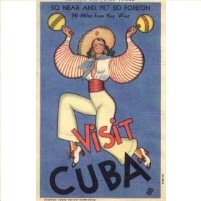Cuba Prepares for American Tourists…Again
Friday, April 17, 2009

As President Barack Obama arrives in Trinidad for the Fifth Summit of the Americas, one of the key issues to be discussed will be the 47-year-old U.S. embargo of Cuba. Despite the fact that Americans are legally banned from visiting Cuba, there is actually a growing wave of American tourists arriving on the island. That’s because it’s easy to avoid the restriction by going to Cuba through a third country, such as Mexico, and having the Cuban authorities not stamp a visitor’s passport.
Many Cubans say they would welcome more open and frequent contact with Americans, particularly as it could prove an important source of income for the struggling Cuban economy.
Last year, Cuba welcomed 2.3 million visitors, who brought in $2.5 billion in revenue. Most tourists to Cuba come from Europe, but more than a quarter are Canadians. Because the United States is only 90 miles away from Cuba, it is only natural that once the travel ban is lifted, Americans, attracted by Cuban beaches, music…and cigars, will come in large numbers.
However, despite a professed openness by both sides and the Obama administration’s initial relaxation of restrictions on travel and remittances for Cuban Americans, a complete overhaul of the embargo by the Obama administration does not seem imminent. Additionally, some question whether the Cuban tourism infrastructure is even prepared to handle an influx of American visitors. The International Monetary Fund has predicted that 3.5 million Americans would visit Cuba annually in the event of the removal of the travel ban, but travel experts estimate that the island nation can only handle a maximum of 500,000. The Cuban government has been working on a number of tourism development projects recently, but would still require a much greater number of tourist amenities to accommodate such an increased flow. There are also concerns among Cubans that American tourism could once again turn Havana into the organized crime-infested playground for wealthy Americans that it was before the 1959 revolution.
It is worth noting that the most powerful force in the tourist industry in Cuba is the Gaviota conglomerate, which is overseen by the Cuban military, which was headed from 1959 until 2008 by Fidel Castro’s brother, Raúl, who is now the president of Cuba.
-Lucy Benz-Rogers, David Wallechinsky
American Tourists at Home in Cuba (by Tracy Wilkinson, Los Angeles Times)
Cuba Readies for Possible Influx of U.S. Tourists (by Jeff Franks, Reuters)
Latin America to Push Obama on Cuba Embargo at Summit (by Joshua Goodman, Bloomberg)
Cuba, the Low-Hanging Fruit for Obama, Braces for Change (by Richard Walden, The Huffington Post)
- Top Stories
- Unusual News
- Where is the Money Going?
- Controversies
- U.S. and the World
- Appointments and Resignations
- Latest News
- Can Biden Murder Trump and Get Away With it?
- Electoral Advice for the Democratic and Republican Parties
- U.S. Ambassador to Greece: Who is George Tsunis?
- Henry Kissinger: A Pre-Obituary
- U.S. Ambassador to Belize: Who is Michelle Kwan?






Comments